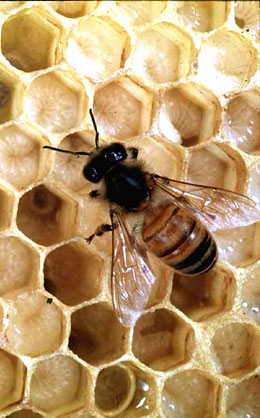WEB FOCUS
Honeybee genome

In this focus
Honeybees have fascinating social structure and advanced societies despite having brains that are five orders of magnitude smaller than humans. An international consortium here reports the genome sequence of the honeybee. Initial analysis of gene content and evolution yields insight into how they accomplish such complex organisation and behaviours such as the famous 'waggle dance'. This special Nature web focus celebrates the publication of the honeybee genome with video interviews and news analysis of the primary research papers, and a comprehensive archive of all matters Apis mellifera.
Image: Jeff Pettis, USDA-ARS Bee Research Lab
Top of page
Video
Enjoy exclusive video of scientists from the bee genome consortium discussing how the project was completed and what it tells us about the life and societies of honeybees.
Top of page
Current Research
ARTICLE
Insights into social insects from the genome of the honeybee Apis mellifera Free access
The Honeybee Genome Sequencing Consortium et al.
Nature 443, 931-949 (26 October 2006) doi:10.1038/nature05260
Abstract | Full Text | PDF | Supplementary Information
NEWS FEATURE
Genomics: How to make a social insect
Edward O. Wilson
Nature 443, 919-920(26 October 2006) doi:10.1038/443919a
NEWS
From hive to human.
Erika Check
Nature 443, 893 (26 October 2006) doi:10.1038/443893a
Top of page
Podcast

Hear more about honeybee behaviour and the significance of the sequencing of the bee genome in the 26 October edition of the Nature Podcast.
Top of page
Links
- Genome Research - Published ahead of print
- Insect Molecular Biology - Special Issue
- Honeybee genome database
- BeeSpace
- Baylor Genome Project site
- Genome assembly at UCSC
- Genome page at NIH
- Bee links from USDA
- BeeBase at MSU
- BeeBase in the UK
- National Honey Board
Top of page
Archive
LETTER
Honeybee colonies achieve fitness through dancing
Gavin Sherman, P. Kirk Visscher
Nature 419, 920 - 922 (31 Oct 2002) doi:10.1038/nature01127
LETTER
Honeybee dances communicate distances measured by optic flow
Harald E. Esch, Shaowu Zhang, Mandyan V. Srinivasan, Juergen Tautz
Nature 411, 581 - 583 (31 May 2001) doi:10.1038/35079072
ARTICLE
Chronobiology: Reversal of honeybee behavioural rhythms
Guy Bloch, Gene E. Robinson
Nature 410, 1048 - 1048 (26 Apr 2001) doi:10.1038/35074183
LETTER
The concepts of 'sameness' and 'difference' in an insect
Martin Giurfa et al.
Nature 410, 930 - 933 (19 Apr 2001) doi:10.1038/35073582
LETTER
Ontogeny of orientation flight in the honeybee revealed by harmonic radar
Elizabeth A. Capaldi et al.
Nature 403, 537 - 540 (03 Feb 2000) doi:10.1038/35000564
LETTER
Representations of odours and odour mixtures visualized in the honeybee brain
Jasdan Joerges, Armin Küttner, C. Giovanni Galizia, Randolf Menzel
Nature 387,285 - 288 (15 May 1997) doi:10.1038/387285a0
LETTER
Selective neuroanatomical plasticity and division of labour in the honeybee.
Ginger S. Withers, Susan E. Fahrbach, Gene E. Robinson
Nature 364, 238 - 240 (15 July 1993) doi:10.1038/364238a0
LETTER
An identified neuron mediates the unconditioned stimulus in associative olfactory learning in
Martin Hammer
Nature 366, 59 - 63 (04 Nov 1993) doi:10.1038/366059a0
LETTER
Gene flow between African- and European-derived honey bee populations in Argentina
Walter S. Sheppard et al.
Nature 349, 782 - 784 (28 Feb 1991) doi:10.1038/349782a0
LETTER
Neotropical Africanized honey bees have African mitochondrial DNA
Deborah Roan Smith, Orley R Taylor, Wesley M. Brown
Nature 339, 213 - 215 (18 May 1989) doi:10.1038/339213a0
LETTER
Worker policing in the honeybee
Francis L. W. Ratnieks, P. Kirk Visscher
Nature 342, 796 - 797 (14 Dec 1989) doi:10.1038/342796a0
LETTER
Evidence from mitochondrial DNA that African honey bees spread as continuous maternal lineages
H. Glenn Hall, K. Muralidharan
Nature 339, 211 - 213 (18 May 1989) doi:10.1038/339211a0
LETTER
A genetic component to division of labour within honey bee colonies
Peter C.Frumhoff , Jayne Baker
Nature 333, 358 - 361 (26 May 1988) doi:10.1038/333358a0
LETTER
Genetic determination of guarding and undertaking in honey-bee colonies
Gene E. Robinson, Robert E. Page
Nature 333, 356 - 358 (26 May 1988) doi:10.1038/333356a0
LETTER
Semiochemical basis of the retinue response to queen honey bees
Keith N. Slessor et al.
Nature 332, 354 - 356 (24 Mar 1988) doi:10.1038/332354a0
LETTER
Genetic kin recognition: honey bees discriminate between full and half sisters
Wayne M. Getz, Katherine B. Smith
Nature 302, 147 - 148 (10 Mar 1983) doi:10.1038/302147a0
LETTER
Behavioural access to short-term memory in bees
Randolf Menzel
Nature 281,368 - 369 (04 Oct 1979) doi:10.1038/281368a0
LETTER
Extraction and Purification of 'Queen Substance' from Queen Bees
C. G. Butler, R. K. Callow, Norah C. Johnston
Nature 184, 1871 - 1871 (12 Dec 1959) doi:10.1038/1841871a0
ARTICLE
Communication in Swarm-Bees Searching for a New Home
M. Lindauer
Nature 179, 63 - 66 (12 Jan 1957) doi:10.1038/179063a0
